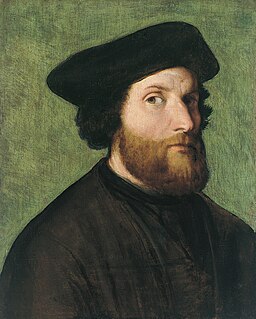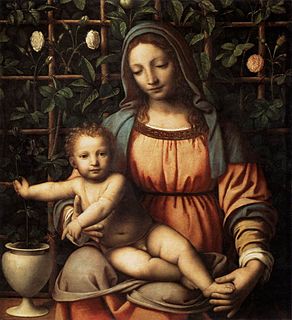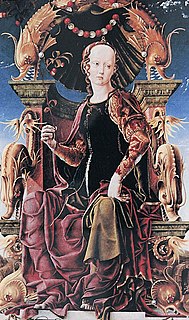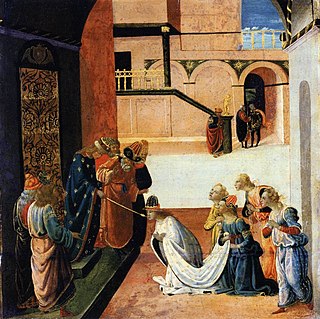
Andrea Mantegna was an Italian painter, a student of Roman archeology, and son-in-law of Jacopo Bellini.

Lorenzo Lotto was an Italian painter, draughtsman, and illustrator, traditionally placed in the Venetian school, though much of his career was spent in other north Italian cities. He painted mainly altarpieces, religious subjects and portraits. He was active during the High Renaissance and the first half of the Mannerist period, but his work maintained a generally similar High Renaissance style throughout his career, although his nervous and eccentric posings and distortions represented a transitional stage to the Florentine and Roman Mannerists.

Vittore Carpaccio was an Italian painter of the Venetian school, who studied under Gentile Bellini. He is best known for a cycle of nine paintings, The Legend of Saint Ursula. His style was somewhat conservative, showing little influence from the Humanist trends that transformed Italian Renaissance painting during his lifetime. He was influenced by the style of Antonello da Messina and Early Netherlandish art. For this reason, and also because so much of his best work remains in Venice, his art has been rather neglected by comparison with other Venetian contemporaries, such as Giovanni Bellini or Giorgione.

BartolomeoMontagna was an Italian Renaissance painter who mainly worked in Vicenza. He also produced works in Venice, Verona, and Padua. He is most famous for his many Madonnas and his works are known for their soft figures and depiction of eccentric marble architecture. He is considered to be heavily influenced by Giovanni Bellini, in whose workshop he might have worked around 1470. Benedetto Montagna, a productive engraver, was his son and pupil and active until about 1540. He was mentioned in Vasari's Lives as a student of Andrea Mantegna but this is widely contested by art historians.

San Leonardo in Arcetri is a Romanesque-style, Roman Catholic church located on Via di San Leonardo #25, a few hundred meters southeast of the Porta San Giorgio of Florence, Italy.

Pietro Perugino, born Pietro Vannucci, was an Italian Renaissance painter of the Umbrian school, who developed some of the qualities that found classic expression in the High Renaissance. Raphael was his most famous pupil.

Benozzo Gozzoli was an Italian Renaissance painter from Florence. A pupil of Fra Angelico, Gozzoli is best known for a series of murals in the Magi Chapel of the Palazzo Medici-Riccardi, depicting festive, vibrant processions with fine attention to detail and a pronounced International Gothic influence. The chapel's fresco cycle reveals a new Renaissance interest in nature with its realistic depiction of landscapes and vivid human portraits. Gozzoli is considered one of the most prolific fresco painters of his generation. While he was mainly active in Tuscany, he also worked in Umbria and Rome.

Carlo Crivelli was an Italian Renaissance painter of conservative Late Gothic decorative sensibility, who spent his early years in the Veneto, where he absorbed influences from the Vivarini, Squarcione, and Mantegna. He left the Veneto by 1458 and spent most of the remainder of his career in the March of Ancona, where he developed a distinctive personal style that contrasts with that of his Venetian contemporary Giovanni Bellini.

Alessandro Bonvicino, more commonly known as Moretto, or in Italian Il Moretto da Brescia, was an Italian Renaissance painter from Brescia, where he also mostly worked. His dated works span the period from 1524 to 1554, but he was already described as a master in 1516. He was mainly a painter of altarpieces that tend towards sedateness, mostly for churches in and around Brescia, but also in Bergamo, Milan, Verona and Asola; many remain in the churches they were painted for. Most are on canvas, but a number even of large ones are on wood panel. Only a handful of drawings survive.

Bernardino Luini was a North Italian painter from Leonardo's circle during the High Renaissance. Both Luini and Giovanni Antonio Boltraffio were said to have worked with Leonardo directly; he was described as having taken "as much from Leonardo as his native roots enabled him to comprehend". Consequently, many of his works were attributed to Leonardo. He was known especially for his graceful female figures with elongated eyes, called Luinesque by Vladimir Nabokov.

Benvenuto Tisi was a Late-Renaissance-Mannerist Italian painter of the School of Ferrara. Garofalo's career began attached to the court of the Duke d'Este. His early works have been described as "idyllic", but they often conform to the elaborate conceits favored by the artistically refined Ferrarese court. His nickname, Garofalo, may derive from his habit of signing some works with a picture of a carnation.

Giovanni Battista Cima, also called Cima da Conegliano, was an Italian Renaissance painter, who mostly worked in Venice. He can be considered part of the Venetian school, though he was also influenced by Antonello da Messina, in the emphasis he gives to landscape backgrounds and the tranquil atmosphere of his works. Once formed his style did not change greatly. He mostly painted religious subjects, often on a small scale for homes rather than churches, but also a few, mostly small, mythological ones.

Cosmê Tura, also known as Il Cosmè or Cosimo Tura, was an Italian early-Renaissance painter and considered one of the founders of the School of Ferrara.

Lippo Memmi was an Italian painter from Siena. He was the foremost follower of Simone Martini, who was his brother-in-law.

Jacopo del Sellaio (1441/2–1493), was an Italian painter of the early Renaissance, active in his native Florence. His real name was Jacopo di Arcangelo. He worked in an eclectic style based on those of Botticelli, Filippino Lippi, and Domenico Ghirlandaio. The nickname Sellaio derives from the profession of his father, a saddle maker.
Giovanni di Francesco del Cervelliera or Giovanni di Francesco was an Italian painter, active in Florence in the mid-fifteenth century.

The Novitiate Altarpiece or Madonna and Child with Saints is a c.1440-1445 tempera on panel painting by Filippo Lippi, now in the Uffizi in Florence. A sacra conversazione, it originally had a predella painted by Pesellino centred on a Nativity. The main panel shows Cosmas and Damian either side of the Madonna and Child, whilst Francis of Assisi is shown at far left and Anthony of Padua at far right. On an architectural frieze above the figures are the Medici's heraldic balls.

The Roverella Altarpiece was a religious painting by Cosmè Tura completed during 1470–1474 using oil and egg-tempera on poplar panel work, commissioned by abbot and cardinal Bartolomeo Roverella for San Giorgio fuori le mura in Ferrara in memory of his brother bishop Lorenzo Roverella. It was one of the most significant works of the artist and of the Ferrara Renaissance in general. It was damaged in an explosion in 1709 and moved out of the church. It is now dismembered and their panels split up between several museums.
























